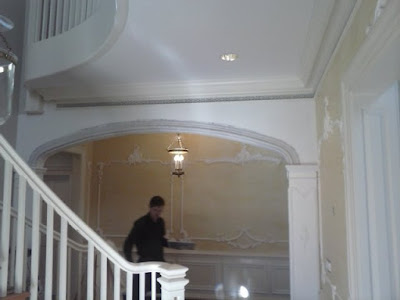 |
| Gold paint on the over-door ornament. This extra long ornament began with the same castings over the other doors, but I extended it by sculpting sections of wet plaster right there on the wall. |
Before the gold paint was applied, a layer of red oxide primer was added. This simulates the red "bole" used in traditional gilding, and is the red-orange colour one sees when old gilding has gotten worn. It adds a richness to the overall finish that is not achieved if the gold is painted directly onto the white surface.
 |
| The red-oxide under-paint |
In most traditional 18th century work one sees of this nature, all of the moulding is gilded, but sometimes one does come across work that is primarily white with gold accents, or where the gold and white are more or less evenly divided. The clients for this job really like the gold and white look much more than all gold, which is more of a Venetian look than a French one; though that is somewhat of a generalisation. (a lot of German Rococo work was also done in gold and white) People's tastes have always varied, and the artists and craftsmen who catered to them have always adapted.
I had originally wanted to do all of the carved ornament in gold, and leave all of the linear borders white. The clients thought that that would still be too much gold, so they suggested doing the carvings in gold and white. Their idea was to leave all of the edges of the sculpted elements white, so that the line of white would flow, unbroken. In theory, it seemed like a viable option, and even the sample that I prepared for them looked good, however, by the time an entire section of wall was finished in that manner, it looked like something from a circus. I hated it.
 |
| I did not even take a picture of the entire wall like this; I did not want to leave any evidence |
After a thorough discussion with the clients, we agreed to increase the gold areas in order to minimise the busyness that the contrasting colours created. One thing that would have helped would have been if the gold were actually genuine leaf, but they do not like bright gold, and wanted a darker, "antique" gold colour. This darker gold also contributes a lot to the sharp contrast between gold and white, and made it more critical to not have so many areas of both colours together.
In the end, we all agreed that leaving a few areas of white, and all the linear elements remaining white did, in fact, give the look that they were after. (I am glad, because I never could have put these pictures on this blog if they had stuck with the first idea!)
 |
| This is the first view one gets of the project as they enter the house and pass through the stair vestibule |
 |
| More free-form sculpted decorations |
 |
| My new favourite vantage point of this project |
 |
| This wall is nearly complete, there is one more frame to the right of the door which still must be completed |
Just to remind everyone of where we started, here is a picture of the early stages of this project. I "took pictures before I started", but later discovered that the card was not in the camera. At this stage, the lower mouldings had already been installed, and most of the walls were plastered. This picture was taken just before the onset of the upper moulding installation.
 |
| It looks so plain and empty by comparison |




























































